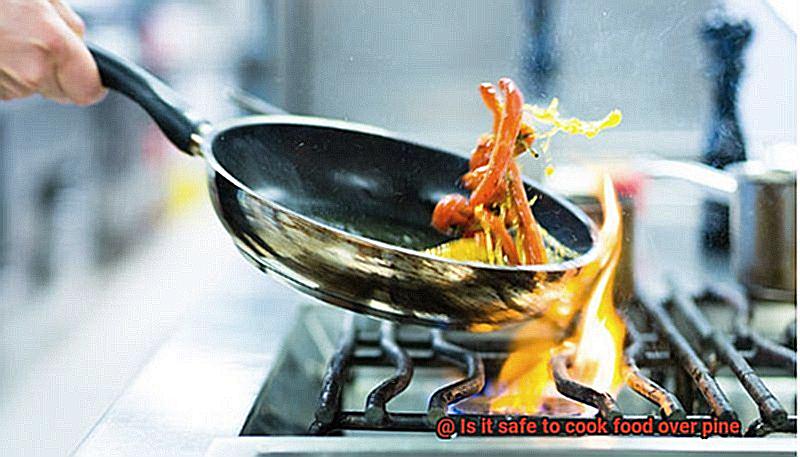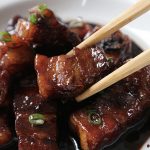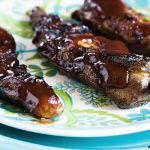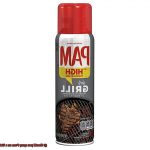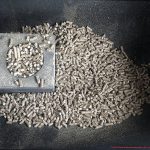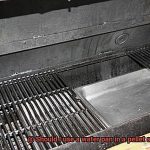Imagine a balmy summer night, the gentle breeze caressing your face, and your loved ones gathered around a roaring campfire. The tantalizing aroma of food grilling over the fire fills the air, and you can’t wait to savor the juicy burgers or succulent chicken skewers. But have you ever pondered whether it’s safe to cook your food over pine branches or pinecones collected from around the firepit?
Cooking food over an open pine fire has been a time-honored tradition cherished for its distinctive flavor. However, concerns about the safety of cooking food over pine have also surfaced due to the release of hazardous substances from the pine smoke, such as benzene, formaldehyde, and other toxic chemicals.
In this article, we’ll delve deeper into this topic and address the burning question: “Is it safe to cook food over pine?” We’ll explore potential health risks associated with cooking food over pine, share tips on maintaining a safe distance from smoke exposure, and discuss alternative firewood options for outdoor cooking. So let’s set the record straight and ensure that you can enjoy your next camping or backyard adventure without any worries.
Contents
The Potential Risks of Cooking Food Over Pine
Grilling food over an open fire is a timeless tradition, but it’s important to be aware of the potential risks associated with cooking food over pine. Pine, a popular choice for outdoor fires, may seem like an easy and convenient option, but it’s worth taking the time to consider some of the dangers.
One significant risk of cooking over pine is the release of harmful chemicals when the wood is burned. Pine contains high levels of resin, which can produce hazardous chemicals such as formaldehyde, benzene, and acrolein. These chemicals can lead to respiratory issues and other health problems if inhaled.
In addition to the risks posed by the chemicals released when pine is burned, there is also a risk of food contamination. Pine needles and other debris can fall onto the food while it’s cooking, leading to potential illness from bacteria growth. Additionally, uneven heat production from pine wood can cause undercooked or overcooked food.
Furthermore, cooking with pine poses a threat to the environment due to the risk of forest fires. Pine needles and other debris can easily ignite in dry conditions, leading to dangerous wildfires that can harm nearby communities and wildlife.
Despite these risks, there are ways to safely cook food over pine. It’s essential to use only dry, seasoned wood and ensure that the fire is burning at a lower temperature. This will reduce the amount of harmful chemicals released into the air.
To avoid contamination from debris falling onto food while cooking, it’s crucial to keep a watchful eye on the fire and clean up any debris as soon as possible. Finally, it’s crucial not to leave the fire unattended as this can quickly lead to dangerous forest fires.
What is Creosote and How Does it Affect Health?
While there’s no denying the allure of these cozy, traditional activities, it’s important to be aware of the potential risks posed by creosote buildup. As an expert on this topic, let me break down exactly what creosote is and how it can affect your health.
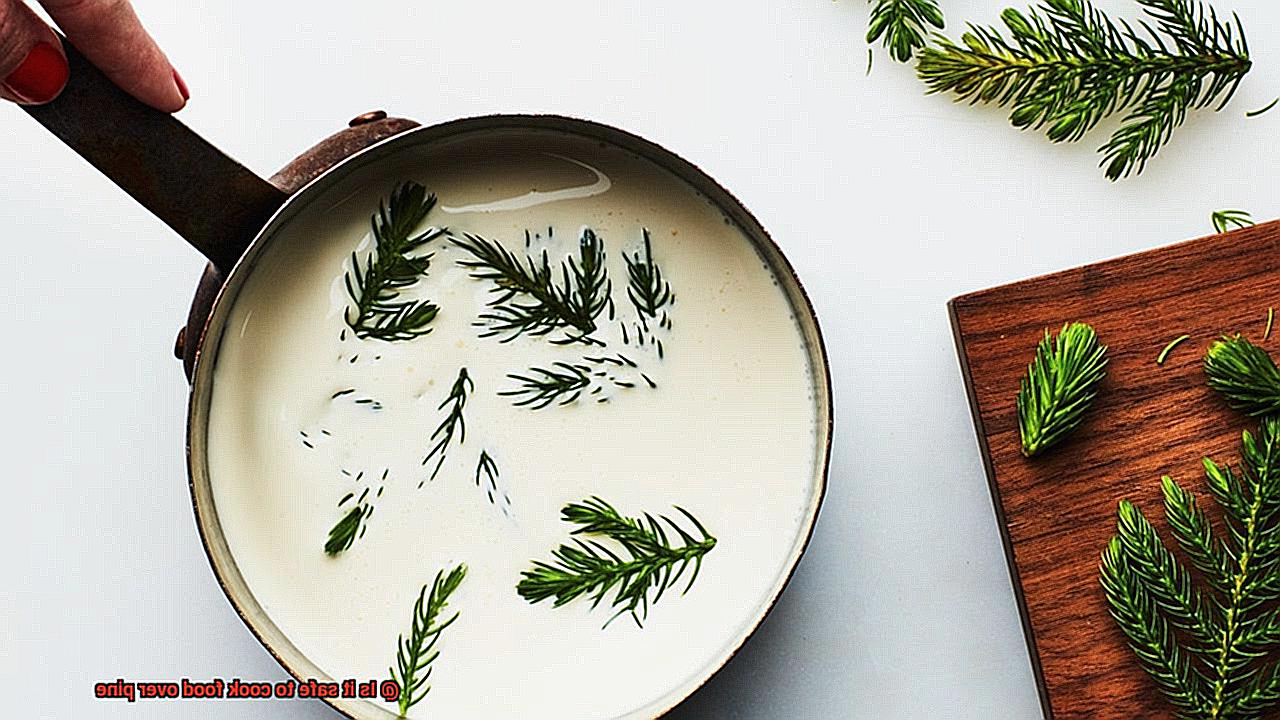
Creosote is a chemical compound that results from burning wood. It’s a dark, oily substance that can accumulate in chimneys and stovepipes if the wood isn’t burned at a high enough temperature. This buildup poses a serious fire hazard, as creosote is highly flammable and can cause chimney fires if it ignites. But that’s not all – creosote can also have negative effects on your health.
When food is cooked over burning wood that contains creosote, the chemical compounds can be released into the air and absorbed by the food. If consumed, these compounds can be harmful to human health. Respiratory issues like coughing, asthma, and bronchitis are some of the possible health effects of creosote exposure. Long-term exposure to creosote has also been linked to an increased risk of cancer, particularly lung cancer.
So how can you reduce your risk of creosote exposure? Firstly, make sure you’re burning wood at a high enough temperature to prevent creosote buildup. When choosing wood for burning or grilling, opt for hardwoods like oak or maple over softwoods like pine as they contain lower levels of creosote. Additionally, avoid charring or burning food over a wood fire as this can release more harmful chemicals into the air.
The Role of Resin in the Release of Harmful Compounds
Attention grill masters. Pine wood is a popular choice for grilling and smoking food due to its distinct aroma and flavor. However, pine wood contains resin, a sticky substance that protects the tree from insects and disease. When burned at high temperatures, this resin melts and releases volatile organic compounds (VOCs) such as formaldehyde, acrolein, and benzene that have been linked to respiratory problems, irritation of the eyes, nose, and throat, and even cancer in some cases.
It is essential to understand the role of resin in releasing harmful compounds when using pine wood for grilling or smoking food. The amount of harmful compounds released varies depending on the temperature at which the wood is burned, the amount of resin present in the wood, and the duration of exposure. Not all pine wood is created equal; some species contain higher levels of resin than others. Ponderosa pine has a higher resin content than white pine.
However, if you choose to use pine wood for your grilling or smoking needs, there are precautions you can take to minimize your risk of exposure to harmful compounds. Firstly, it is recommended to opt for hardwoods such as oak or hickory, which contain lower levels of resin and produce fewer harmful compounds when burned. Secondly, ensure that the pine wood is dry and well-seasoned as this reduces the amount of resin present in the wood. Additionally, avoid burning green or freshly-cut pine wood as they contain more moisture and resin than dry wood.
If you must use pine wood for grilling or smoking food, limit your exposure to smoke by using a smoker box or wrapping your food in foil before placing it on the grill. These measures can significantly reduce your risk of exposure to harmful compounds.
How to Reduce the Risk of Cooking with Pine Wood
While it can add an extra layer of flavor to your meals, it’s important to be aware of the risks associated with cooking with pine wood. Fortunately, there are several steps you can take to reduce those risks and cook safely.
Firstly, make sure you’re using dry and seasoned pine wood for cooking. Freshly cut pine wood contains higher levels of moisture, which can lead to uneven cooking and the production of more smoke and harmful chemicals when burned. Dry wood will create a more stable flame and reduce the amount of resin released during burning.
Secondly, avoid using pine wood that has been treated with chemicals or paint. These substances can release toxic fumes when burned, which can contaminate the food being cooked. Stick to natural, untreated pine wood for a safer cooking experience.
Thirdly, monitoring the fire while cooking with pine wood is crucial. This means keeping a close eye on the flame and adjusting the airflow as needed. Using smaller pieces of pine wood can also help maintain a lower temperature and reduce the risk of harmful chemicals being released.
Another way to reduce the risk is to mix pine wood with other types of wood, such as oak or hickory. This will dilute the amount of resin released during burning and decrease the likelihood of contamination.
Lastly, it’s important to clean your grill or cooking surface thoroughly after using pine wood for cooking. This will help remove any residue or potential contaminants left behind from the burning process.
Properly Seasoning and Storing Pine Wood
If so, pine wood may be the perfect fuel source for your grill or smoker. However, it’s important to understand that not all pine wood is suitable for cooking and even the right type of wood needs to be seasoned and stored properly for safe use.
Seasoning wood is the process of drying it out to reduce its moisture content. Freshly cut pine wood contains a lot of moisture, which can cause problems when used for cooking. Wet wood produces more smoke and can make your food taste bitter or acrid. Additionally, burning wet wood can release harmful chemicals like creosote that can build up in your grill or smoker over time.
To season pine wood, cut it into small pieces and stack them in a dry, well-ventilated area. The wood should be raised off the ground and covered with a tarp or protective covering to keep it dry. Natural drying is best, so avoid using artificial heat sources like kilns. Depending on the humidity in your area, it may take several months for the wood to dry completely.
Storing your seasoned pine wood correctly is just as important as seasoning it. Keep your wood in a dry place away from moisture and pests. Consider storing it in a shed or garage if possible, or use a purpose-built firewood rack that keeps the wood elevated off the ground and protected from rain and snow.
So, properly seasoning and storing pine wood is essential for safe and enjoyable cooking. Here are some key takeaways:
- Seasoning wood means drying it out to reduce its moisture content.
- Wet wood produces more smoke and can cause food to taste bitter or acrid.
- Burning wet wood can release harmful chemicals like creosote that can accumulate in your grill or smoker over time.
- To season pine wood, cut it into small pieces and stack them in a dry, well-ventilated area.
- Store your seasoned pine wood in a dry place away from moisture and pests.
- Consider using a shed, garage, or purpose-built firewood rack for storage.
Maintaining a Low Burning Temperature When Grilling
When it comes to grilling over pine wood, maintaining a low burning temperature is crucial to ensure that your food remains safe and tasty. Pine wood can produce a lot of smoke, which can lead to a bitter taste and potentially harmful substances being absorbed by your food. But don’t worry, with these expert tips, you’ll be able to enjoy a delicious and safe grilling experience every time.
One of the most important things to keep in mind is to use a combination of charcoal and pine wood. Charcoal provides a stable base for grilling, while adding small amounts of pine wood for flavor. Make sure to use dry, aged pine wood as green or wet wood will produce more smoke and potentially harmful chemicals.
Another way to maintain a low burning temperature is by using indirect grilling. This method involves placing the food to the side of the heat source rather than directly over it. This allows for slower cooking and reduces the risk of harmful chemicals being released. Indirect grilling is an excellent way to ensure that your food is cooked evenly and safely.
In addition, keeping your grill clean and well-maintained is crucial. A build-up of grease and debris can cause flare-ups and increase the temperature, leading to the production of harmful toxins. Regularly cleaning the grill grates and removing any excess debris can help you maintain a safe and low temperature for grilling over pine wood.
Using the Right Tools for Cooking over Pine
Before you get started, it’s important to understand the tools and safety precautions necessary to ensure a successful and safe experience.
First and foremost, a sturdy grill grate is essential for cooking over pine. Cast iron or stainless steel are great options as they can withstand high temperatures without warping or breaking. The last thing you want is your food falling through the cracks or your grill collapsing mid-cookout.
Next, invest in a pair of long-handled tongs and spatula. These will allow you to easily flip and move food around on the grill without piercing it with sharp utensils that can cause juices to escape. Plus, using long-handled tools just makes you feel like a pro, doesn’t it?
But safety should always be top of mind when cooking over pine. Make sure to wear heat-resistant gloves or mitts when handling hot items on the grill, and never leave the grill unattended while in use. It’s also important to have a fire extinguisher nearby in case of emergencies.
Another smart move is investing in a meat thermometer. Ensuring that your food is cooked to a safe temperature can prevent harmful bacteria from making an appearance at your cookout. This is especially important when cooking poultry or ground meats.
To summarize, here’s a quick checklist of the tools and safety precautions necessary for a successful and safe cookout over pine:
- Sturdy grill grate made of cast iron or stainless steel
- Long-handled tongs and spatula
- Heat-resistant gloves or mitts
- Fire extinguisher nearby
- Meat thermometer
Advantages of Cooking with Pine Wood
Look no further than pine wood. Cooking with pine wood has many advantages that can make your outdoor cooking experience even better.
Firstly, the distinct aroma and flavor of pine wood can add depth and richness to your grilled meats and vegetables. Its natural smoky flavor is sure to impress even the most discerning palates. Moreover, pine wood burns evenly and consistently, giving you greater control over the heat on your grill. Say goodbye to hotspots and flare-ups.
Cleaning up after cooking has never been easier. Pine wood produces minimal ash, reducing the time spent cleaning your grill. You can now spend more time enjoying your delicious food with family and friends.
Additionally, pine wood is affordable and easily accessible. Pine trees are distributed widely throughout North America and Europe, making it an effortless option for outdoor chefs. Even those on a budget can enjoy the benefits of cooking with pine wood.
Lastly, let’s talk about the environment. Pine trees are sustainable and grow quickly, making them an eco-friendly source of fuel for grilling. Cooking with pine wood doesn’t release harmful chemicals or pollutants into the air, making it a safe and responsible choice for the planet.
22jX7ifvRhQ” >
Conclusion
In conclusion, the age-old tradition of cooking food over pine has been cherished for its unique and delicious flavor. However, recent concerns about the safety of this practice have emerged due to the release of hazardous substances like benzene and formaldehyde from pine smoke. But don’t worry, there are ways to safely cook food over pine by using dry and seasoned wood while ensuring that the fire is burning at a lower temperature. Keeping a watchful eye on the fire is also crucial to avoid contamination from falling debris.
It’s important to note that creosote buildup can be harmful when consumed through food cooked over burning wood. To avoid this, choose hardwoods like oak or maple instead of softwoods like pine as they contain lower levels of creosote. Also, avoid charring or burning food over a wood fire as it releases more harmful chemicals into the air.
While cooking with pine wood can add an extra layer of flavor to your meals, it’s essential to be aware of the risks associated with it. Proper seasoning and storing of pine wood are necessary for safe and enjoyable cooking. Maintaining a low burning temperature while grilling ensures that your food remains both safe and tasty.
Cooking with pine wood has many advantages that can enhance your outdoor cooking experience. Pine trees grow quickly, making them an eco-friendly source of fuel for grilling while being affordable and easily accessible.

